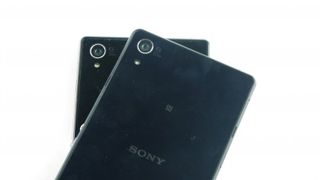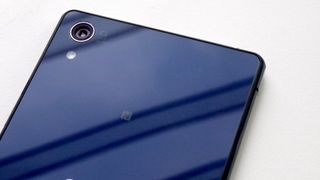Samsung Galaxy S5 vs Sony Xperia Z2
An early look at Barcelona's headliners

Camera
Sony has always prided itself on having one of the best cameras around thanks to its Cybershot heritage, but Samsung's efforts in 2014 have been about getting something that will simply deliver shots that users want.
A 16MP sensor is a slight hike in specs, but that's not what Samsung is touting. Its 'big thing' is actually twofold: the ability to take a picture, with autofocus, in a fraction of a second, and the chance to take a snap and then blur out the background... in actual fact, change the focal point post-snap thanks to the Selective Focus mode.

Sadly, the latter feature is bordering on the completely useless. The phone takes a few photos in succession and then stitches them together, and once processed will then let you change the focus to one of three levels. The whole thing has to be enabled each time, takes a long time and fails on too many occasions (when you shake the camera).
However, the speedy autofocus does really work, with clear pictures appearing even when whirling the phone around to simulate drunken antics. Samsung is at least trying to innovate in the right way here, but we fear that it's not going to have enough of a headline spec in this area.
Sony hasn't done a lot better in terms of upgrades, but that's mostly because it's updating a phone that was only launched in September. It's got the 20.7MP sensor with G Lens, Bionz image processing and Exmor RS technology, designed to improve images no end.

It too also has the same background de-focus ability, and it seems to work better than Samsung's option in our early tests. However, we've got some qualms over the snapper; while it's immensely powerful, on the Xperia Z1 it wasn't the best in low light, introducing a lot of noise to the pics.
Given the Xperia Z2 hasn't been overly upgraded in this area, we're worried the same thing will be happening again - but we'll give Sony the benefit of the doubt. Plus it's also added in the same slo-mo video ability that Apple did with the iPhone 5S (although Sony is calling it TimeShift video), so at least there's new stuff to play with.
Get daily insight, inspiration and deals in your inbox
Get the hottest deals available in your inbox plus news, reviews, opinion, analysis and more from the TechRadar team.
On top of that, both phones are able to shoot in 4K, which is probably more of a gimmick than anything else at this point - Sony is highlighting how it will allow you to zoom into the footage and still have Full HD sharpness, but that sounds like it could be hard to actually achieve.
Other features
This is where things get a little more friendly for Samsung, depending on your viewpoint. The Galaxy S5 has a lot of new features in the health and fitness arena - not least the fact it actually packs a heart rate sensor on the phone itself, nestled just below the camera.
It's something fun to show off in the pub, and does actually work... although because it only will read your pulse when you ask it to, it won't be great at showing long term health benefits as you'll probably forget to do it on some days. Much better would have been the phone to monitor your heart rate whenever you picked up the phone somehow, and allowed for a daily average.

But there's more too: the S Health app is better than ever at tracking your activity, can give more info about your dietary habits and will offer the most information about your surroundings (it's even able to monitor humidity).
Samsung has also pulled another feature into the mix by using a fingerprint scanner – it's not as good as Apple's implementation, simply because it needs a press and a swipe to enable, but it's more feature packed thanks to being able to safeguard certain areas of the phone.
The South Korean brand has also signed a deal with PayPal to let you securely pay for things online using your biometric data from your digit – although we're awaiting information on whether this will apply to all websites that run the payment method, or just those that opt in.

Sony, on the other hand, has focused on making a strong and easy to use phone, devoid of a real headline extra beyond, perhaps, the 4K video recording and waterproof, well-polished body.
It's also running MHL 3.0, which is actually a nifty feature because it supports 4K video and 7.1 surround sound… it might be ahead of the curve, but that's fully where we like our technology to sit.
Price
If you're thinking you're going to choose one of these phones based on whichever is cheaper, then chances are you're going to be out of luck. Both are being offered for the same price SIM free (sadly right at the very top end of the price spectrum) and while we don't have much in the way of contract prices, we've been reliably informed that both will sit at the top of the price tree.
That makes a lot of sense given they're the flagship devices for their brands, and we expect the New HTC One / M8 to follow the same structure when it appears.
So there you have it – two phones packed to the rafters with new features. The only question is whether you fancy one that's more sleek and refined, that eschews headline features to create a more dependable package, or one that gives you power, functionality and new options to move the smartphone message on.
We'll leave you to work out which is which.

Gareth has been part of the consumer technology world in a career spanning three decades. He started life as a staff writer on the fledgling TechRadar, and has grown with the site (primarily as phones, tablets and wearables editor) until becoming Global Editor in Chief in 2018. Gareth has written over 4,000 articles for TechRadar, has contributed expert insight to a number of other publications, chaired panels on zeitgeist technologies, presented at the Gadget Show Live as well as representing the brand on TV and radio for multiple channels including Sky, BBC, ITV and Al-Jazeera. Passionate about fitness, he can bore anyone rigid about stress management, sleep tracking, heart rate variance as well as bemoaning something about the latest iPhone, Galaxy or OLED TV.
Most Popular


